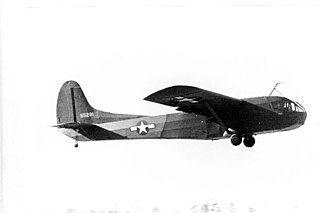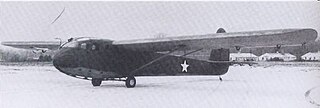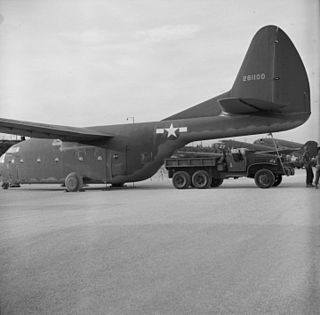Related Research Articles

Lubbock Preston Smith International Airport is five miles north of Lubbock, in Lubbock County, Texas. Originally Lubbock International Airport, it was renamed in 2004 for former Texas governor Preston E. Smith, an alumnus of Texas Tech University.

The Continental O-170 engine is the collective military designation for a family of small aircraft engines, known under the company designation of A50, A65, A75 and A80. The line was designed and built by Continental Motors commencing in the 1940s. It was employed as the powerplant for civil and military light aircraft.

Military gliders have been used by the militaries of various countries for carrying troops and heavy equipment to a combat zone, mainly during the Second World War. These engineless aircraft were towed into the air and most of the way to their target by military transport planes, e.g., C-47 Skytrain or Dakota, or bombers relegated to secondary activities, e.g., Short Stirling. Most military gliders do not soar, although there were attempts to build military sailplanes as well, such as the DFS 228.
Rearwin Airplanes was a series of US airplane-manufacturing businesses founded by Andrew ("Rae") Rearwin in 1928. Rae Rearwin was an American businessman who had developed several successful business ventures in the Salina, Kansas area in the early 20th century. Although he had no experience with aircraft manufacturing, he felt that he could succeed with his solid business acumen. With his two sons, Ken and Royce, he hired some engineers and built the Ken-Royce in a garage in Salina. The business moved to the Fairfax Airport in Kansas City, Kansas, and went through several variations before it was sold to Commonwealth Aircraft in 1942, which went bankrupt in 1946.

The Franklin O-200 was an American air-cooled aircraft engine of the early 1940s. The engine was of four-cylinder, horizontally-opposed layout and displaced 200 cu in (3 L). The power output ranged between 65 hp (48 kW) and 100 hp (75 kW) depending on variant. The O-200-5 (4ACG-199) featured a geared propeller drive.

The Waco CG-15 was an American military glider, which was developed from the CG-4. Although outwardly similar to its predecessor and carrying the same number of passengers, a number of changes in the design, including shortened wings and a more streamlined nose enabled it to travel faster. 1,000 were ordered and 473 were delivered before production ceased. Two were transferred to the Navy for testing as the XLR2W-1. One unit was converted into an XPG-3 powered glider which used two Jacobs R-755-9 radial engines.

The Waco Aircraft Company (WACO) was an aircraft manufacturer located in Troy, Ohio, United States. Between 1920 and 1947, the company produced a wide range of civilian biplanes.

The Waco CG-3A was a US light troop military glider of World War II.

The Waco CG-4 was the most widely used American troop/cargo military glider of World War II. It was designated the CG-4A by the United States Army Air Forces, and given the service name Hadrian by the British.
Ikarbus a.d. is a Serbian bus manufacturer based in Zemun.

The Commonwealth Skyranger, first produced as the Rearwin Skyranger, was the last design of Rearwin Aircraft before the company was purchased by a new owner and renamed Commonwealth Aircraft. It was a side-by-side, two-seat, high-wing taildragger.

The Rearwin Sportster is a 1930s American two-seat, high-winged, cabin monoplane designed and built by Rearwin Aircraft & Engines for sport/touring use.

Fairfax Municipal Airport was a Kansas City, Kansas airfield from 1921 that was used during 1935–1949 by the military. Federal land adjacent to the airfield included a WWII B-25 Mitchell plant and modification center and a Military Air Transport terminal. After being used as a Cold War-era Air Force Base, it was used for airliner servicing by TWA and for automobile and jet fighter aircraft production by General Motors, which built a 1985 Fairfax Plant over runways when the municipal airport closed.

The Cornelius XFG-1 was an American military fuel transporting towed glider, without a tailplane and with a forward-swept wing. Two were built but development ended in 1945.

LeBlond Aircraft Engine Corporation was a small engine manufacturer incorporated on April 11, 1928 and located on the northwest corner of Madison and Edwards Roads in Norwood, Ohio as a subsidiary of the R. K. LeBlond Machine Tool Company in Cincinnati, Ohio, a well known manufacturer of machinist lathes.
Melvin Eugene "Gene" Salvay was an American aircraft engineer.

The 80th Flying Training Wing was a training wing of the United States Army Air Forces. It was last assigned to the Central Flying Training Command, and was disbanded on 16 June 1946 at Ellington Field, Texas.
Dwane Leon Wallace was an American aviation businessman and aircraft designer. He served as the President and/or chairman of the board of the Cessna Aircraft Company from 1935 until the 1970s, having then continued on the board as a director and consultant into the 1980s. Wallace later became known as the "Quiet Giant of Aviation", and was posthumously inducted into the National Aviation Hall of Fame in 2012. He was included in the Flying Magazine list of the "51 Heroes of Aviation", placing at number 11.

The Laister-Kauffman CG-10 was an American military transport glider aircraft developed during World War II.

Victorville Army Airfield auxiliary fields were four airfields used during World War II to support the Victorville Army Airfield pilot training near Victorville, California, and Adelanto, California. After the war the Victorville Army Airfield was renamed George Air Force Base on January 13, 1948. The airfields were built in 1941 by the United States Army Air Corps just before the war. Victorville Army Airfield covered 2,200-acre in the Mojave Desert. The US Army held a groundbreaking ceremony on 12 July 1941. The base, called Victorville Army Flying School, was ready to use before the attack on Pearl Harbor on December 7, 1941. The Army built four runways in a triangle configuration, with one runway down the middle of the triangle. Seven hangars were built to support operation. On April 23, 1943, the base was renamed Victorville Army Airfield.
References
| Wikimedia Commons has media related to Commonwealth Aircraft . |
- 1 2 3 4 5 6 7 8 9 Wright, Bill (1997). Rearwin: A Story of Men, Planes, and Aircraft Manufacturing During the Great Depression . Manhattan, Kansas: Sunflower University Press. ISBN 0-89745-207-0.
- 1 2 Freeman, Paul. "Abandoned and Little-Known Airfields: New York: Long Island, Nassau County". Abandoned and Little-Known Airfields. Retrieved 22 December 2018.
- ↑ "War Front: Frank Cohen, Munitionsmaker". Time . November 3, 1941. Retrieved 22 December 2018.
- ↑ Taylor, Michael J. H. (1989). Jane's Encyclopedia of Aviation. London: Studio Editions. p. 56.